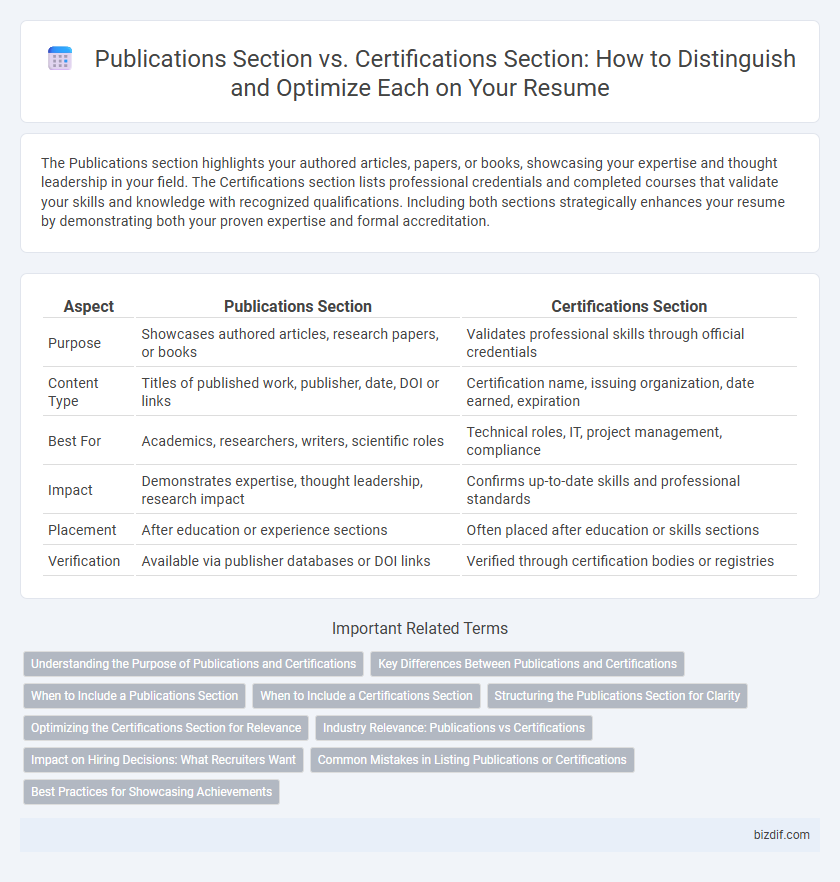The Publications section highlights your authored articles, papers, or books, showcasing your expertise and thought leadership in your field. The Certifications section lists professional credentials and completed courses that validate your skills and knowledge with recognized qualifications. Including both sections strategically enhances your resume by demonstrating both your proven expertise and formal accreditation.
Table of Comparison
| Aspect | Publications Section | Certifications Section |
|---|---|---|
| Purpose | Showcases authored articles, research papers, or books | Validates professional skills through official credentials |
| Content Type | Titles of published work, publisher, date, DOI or links | Certification name, issuing organization, date earned, expiration |
| Best For | Academics, researchers, writers, scientific roles | Technical roles, IT, project management, compliance |
| Impact | Demonstrates expertise, thought leadership, research impact | Confirms up-to-date skills and professional standards |
| Placement | After education or experience sections | Often placed after education or skills sections |
| Verification | Available via publisher databases or DOI links | Verified through certification bodies or registries |
Understanding the Purpose of Publications and Certifications
The Publications section highlights authored articles, research papers, or books that demonstrate subject matter expertise and thought leadership in a professional field. The Certifications section emphasizes officially recognized qualifications and completed training programs that validate specific skills and knowledge relevant to the job. Understanding the distinct purpose of each section ensures effective resume organization, showcasing credibility through publications and qualifications through certifications.
Key Differences Between Publications and Certifications
Publications showcase original research, articles, or papers authored and are typically listed with titles, publication names, and dates, highlighting expertise and thought leadership. Certifications demonstrate completion of professional courses or exams, proving specific skills or qualifications validated by recognized institutions. While publications emphasize knowledge contribution and intellectual achievements, certifications validate practical competencies and industry standards compliance.
When to Include a Publications Section
Including a Publications section on a resume is essential when applying for academic, research, or scientific positions, where demonstrating authored articles, papers, or peer-reviewed studies adds credibility. This section highlights expertise and contributions to the field, showcasing intellectual authority and industry recognition. For most other roles, a Certifications section is more relevant, emphasizing professional qualifications and technical skills.
When to Include a Certifications Section
Include a Certifications Section in your resume when your professional qualifications require industry-recognized credentials, such as PMP, CPA, or AWS certifications, which demonstrate expertise and validate your skills. This section is essential for roles in IT, healthcare, finance, and project management where certifications are often prerequisites or highly valued. Publications are better suited for academic, research, or writing-focused positions, while certifications highlight practical, verifiable qualifications relevant to your career goals.
Structuring the Publications Section for Clarity
Structuring the Publications section with clear headings, consistent formatting, and complete citations enhances readability and professionalism. Include key details such as authorship, publication titles, journal names, volumes, pages, and dates to ensure transparency and credibility. Separating peer-reviewed articles, conference papers, and other publications into distinct subcategories supports quick scanning and better organization.
Optimizing the Certifications Section for Relevance
Emphasizing the Certifications Section over the Publications Section enhances resume relevance by showcasing industry-recognized skills and qualifications directly aligned with job requirements. Highlight certifications that validate expertise in key areas such as project management, cybersecurity, or software proficiency to increase credibility with hiring managers. Tailoring certifications to the specific role demonstrates commitment to professional development and practical applicability.
Industry Relevance: Publications vs Certifications
Publications demonstrate thought leadership and subject matter expertise, often valued in academic, research, and specialized industry roles. Certifications provide verified proof of skills and updated knowledge, preferred in technology, healthcare, and regulatory-driven sectors. Emphasizing industry relevance, candidates should highlight publications for roles requiring innovation and deep expertise, while prioritizing certifications for positions demanding practical skills and compliance.
Impact on Hiring Decisions: What Recruiters Want
Recruiters prioritize the Publications section when candidates demonstrate subject matter expertise and contribute original research relevant to the job role, enhancing credibility in specialized fields. Certifications section is favored for showcasing verified skills and industry-recognized qualifications that align with the specific technical requirements of the position. Effectively balancing both sections improves a resume's impact by highlighting both practical expertise and professional commitment, directly influencing hiring decisions in competitive markets.
Common Mistakes in Listing Publications or Certifications
Listing publications in a resume without proper citation details such as author names, publication titles, dates, and journal or conference names weakens credibility and clarity. Including certifications that are expired, irrelevant to the job role, or lacking verification details can mislead recruiters and reduce the impact of this section. Common mistakes also include mixing publications and certifications within the same section, which dilutes the focus and reduces the effectiveness of both achievements.
Best Practices for Showcasing Achievements
Highlight publications in the Publications section by listing peer-reviewed articles, books, and conference papers with full citations to demonstrate expertise and thought leadership. Use the Certifications section to showcase relevant professional licenses, technical certifications, and completed courses that validate skills and qualifications. Separate these sections clearly on a resume to improve readability and emphasize both academic contributions and practical professional achievements effectively.
Publications Section vs Certifications Section Infographic

 bizdif.com
bizdif.com